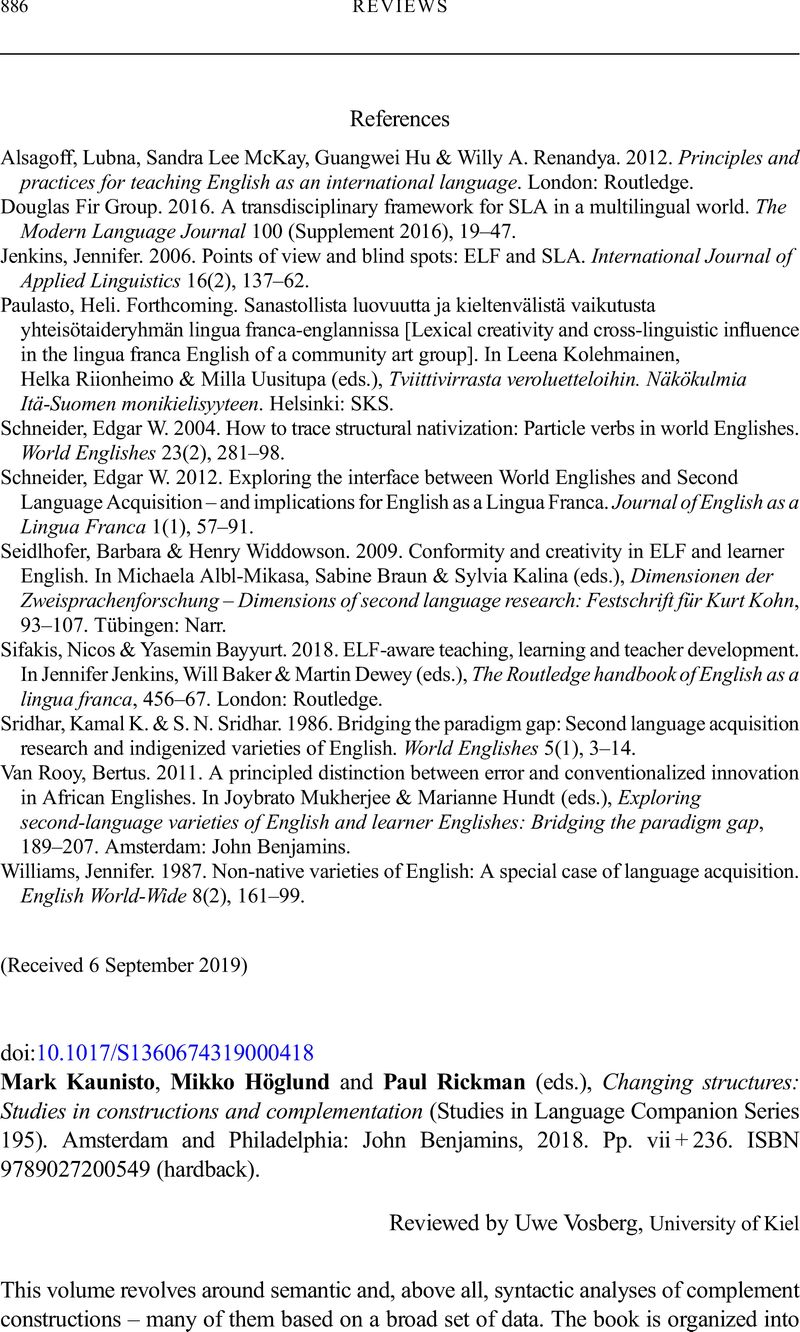No CrossRef data available.
Article contents
Mark Kaunisto, Mikko Höglund and Paul Rickman (eds.), Changing structures: Studies in constructions and complementation (Studies in Language Companion Series 195). Amsterdam and Philadelphia: John Benjamins, 2018. Pp. vii + 236. ISBN 9789027200549 (hardback).
Published online by Cambridge University Press: 30 March 2020
Abstract
An abstract is not available for this content so a preview has been provided. Please use the Get access link above for information on how to access this content.

- Type
- Book Review
- Information
- Copyright
- Copyright © Cambridge University Press 2020
References
Fanego, Teresa. 1996a. On the historical development of English retrospective verbs. Neuphilologische Mitteilungen 97, 71–9.Google Scholar
Fanego, Teresa. 1996b. The development of gerunds as objects of subject-control verbs in English (1400–1760). Diachronica 13, 29–62.CrossRefGoogle Scholar
Goldberg, Adele E. 2014. Fitting a slim dime between the verb template and argument structure construction approaches. Theoretical Linguistics 40(1–2), 113–35.CrossRefGoogle Scholar
Hawkins, John A. 1999. Processing complexity and filler-gap dependencies across grammars. Language 75, 244–85.CrossRefGoogle Scholar
Hundt, Marianne & Mair, Christian. 1999. ‘Agile’ and ‘uptight’ genres: The corpus-based approach to language change in progress. International Journal of Corpus Linguistics 4, 221–42.CrossRefGoogle Scholar
Krug, Manfred. 1998. String frequency: A cognitive motivating factor in coalescence, language processing, and linguistic change. Journal of English Linguistics 26(4), 286–320.CrossRefGoogle Scholar
Los, Bettelou. 2005. The rise of the to-infinitive. Oxford: Oxford University Press.CrossRefGoogle Scholar
Noël, Dirk. 1997. The choice between infinitives and that-clauses after believe. English Language and Linguistics 1(2), 271–84.CrossRefGoogle Scholar
Noël, Dirk. 1998. Infinitival copular complement clauses in English: Explaining the predominance of passive matrix verbs. Linguistics 36(6), 1045–63.CrossRefGoogle Scholar
Noël, Dirk. 2003. Is there semantics in all syntax? The case of accusative and infinitive constructions vs. that-clauses. In Rohdenburg, Günter & Mondorf, Britta (eds.), Determinants of grammatical variation in English, 347–77. Berlin and New York: Mouton de Gruyter.Google Scholar
Rohdenburg, Günter. 1996. Cognitive complexity and increased grammatical explicitness in English. Cognitive Linguistics 7, 149–82.CrossRefGoogle Scholar
Rudanko, Juhani. 2000. Corpora and complementation: Tracing sentential complementation patterns of nouns, adjectives and verbs over the last three centuries. Oxford: University Press of America.Google Scholar
Rudanko, Juhani 2006. Emergent alternation in complement selection. The spread of transitive into -ing constructions in British and American English. Journal of English Linguistics 34, 312–31.CrossRefGoogle Scholar
Schlüter, Julia. 2005. Rhythmic grammar: The influence of rhythm on grammatical variation and change in English. Berlin and New York: Mouton de Gruyter.CrossRefGoogle Scholar
Vosberg, Uwe. 2006. Die Große Komplementverschiebung: Außersemantische Einflüsse auf die Entwicklung satzwertiger Ergänzungen im Neuenglischen. Tübingen: Narr.Google Scholar





